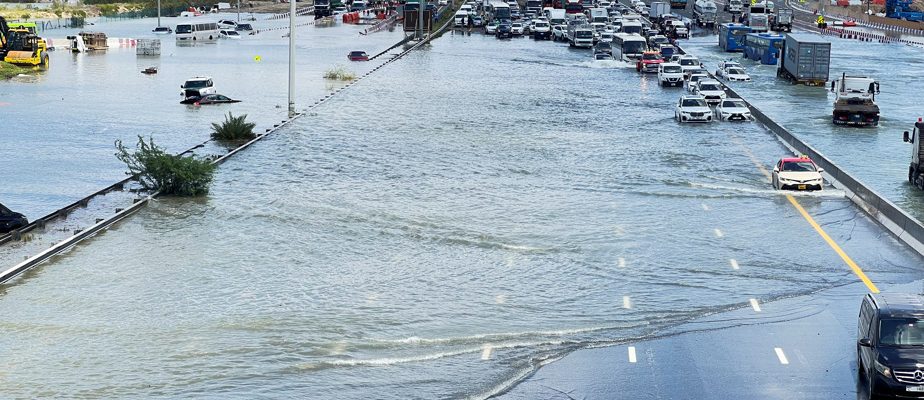(Dubai) The desert country of the United Arab Emirates was trying to recover from the heaviest rains on record on Wednesday after a deluge flooded Dubai International Airport, disrupting flights at the country’s busiest airfield. world for international travel.
The government news agency WAM called Tuesday’s rains a “historic weather event,” surpassing “anything documented since data collection began in 1949” ― that is, before the discovery of crude oil in this energy-rich country which was then part of a British protectorate.
Rain also fell in Bahrain, Oman, Qatar and Saudi Arabia. Rains were intense across the United Arab Emirates.
One reason could be “cloud seeding,” where small government-operated planes fly through clouds burning special salt flares. These flares can increase precipitation.
Several reports cite meteorologists from the National Meteorological Center who said they conducted six or seven cloud-seeding flights before the rains. Flight tracking data analyzed by The Associated Press showed that a plane affiliated with the United Arab Emirates’ cloud-seeding efforts flew around the country on Monday.
The National, an English-language newspaper in Abu Dhabi, on Wednesday quoted an unnamed official at the center as saying no cloud seeding had taken place on Tuesday, without acknowledging the existence of previous flights.
The center did not respond to questions from the AP on Wednesday.
The United Arab Emirates, which relies heavily on energy-intensive desalination plants for its water supply, conducts cloud seeding in part to increase its water table, which is limited and dwindling. Scientists also say that climate change in general is responsible for increasing the intensity and frequency of extreme storms, droughts, floods and wildfires around the world.
The rains began late Monday, soaking Dubai’s sands and roads with some 20 millimeters of rain, according to weather data collected at Dubai International Airport. Thunderstorms intensified around 9 a.m. local time on Tuesday and continued throughout the day, dumping more rain and hail on the submerged city.
By the end of Tuesday, more than 142 millimeters of rain had fallen on Dubai in 24 hours. On average, 94.7 millimeters of rain falls per year at Dubai International Airport, the hub of long-haul airline Emirates.
At the airport, standing water lapped on the taxiways as planes landed. Arrivals were disrupted Tuesday evening, and passengers struggled to reach terminals through floodwaters that covered surrounding roads.
Dubai International Airport admitted on Wednesday morning that flooding had limited transport options and affected flights, with crews unable to access the airfield.
“Recovery will take some time,” the airport warned on the social platform X.
Emirates said the airline halted check-in for passengers departing from Dubai from 8 a.m. until midnight on Wednesday, to free the airport of transit passengers, many of whom were sleeping wherever they could in its terminals. cavernous.
Passengers on FlyDubai, Emirates’ low-cost sister airline, have also experienced disruption.
Paul Griffiths, the airport’s chief executive, acknowledged continued flooding problems on Wednesday morning, saying every place where a plane could be parked safely was occupied. Some planes were diverted to Dubai World Central’s Al Maktoum International Airport, the city-state’s second airfield.
“We are living through incredibly difficult times. I don’t think we’ve ever seen conditions like this in living memory, Griffiths told public radio station Dubai Eye. We are in uncharted territory, but I can assure everyone that we are working as hard as possible to ensure our customers and staff are taken care of. »
Egypt’s national carrier, EgyptAir, also temporarily suspended its flights between Cairo and Dubai due to bad weather.
Schools in the UAE were largely closed ahead of the storm and government employees worked remotely where possible. Many workers also stayed at home, but some ventured outside, and the unfortunate people stopped their vehicles in the deeper-than-expected water that covered some roads. This is the case for parts of Sheikh Zayed Road, a 12-lane highway that runs through downtown Dubai.
Authorities sent tanker trucks onto streets and highways to pump out water.
The country’s hereditary rulers did not provide information on damage or injuries, with some sleeping in their flooded vehicles Tuesday night. In Ras al-Khaimah, the country’s northernmost emirate, police said a 70-year-old man died when his vehicle was swept away by floodwaters.
Khatm al-Shakla, an area near Al Ain in Abu Dhabi, received 254 millimeters of rain on Tuesday, the highest amount in the entire country, according to authorities.
Authorities canceled classes and the government reinstated remote working for Wednesday.
Rain is rare in the United Arab Emirates, an arid country on the Arabian Peninsula, but it occurs periodically during the cooler winter months. Many roads and other areas are not drained due to lack of regular rainfall, causing flooding.
In the neighboring sultanate of Oman, located on the eastern tip of the Arabian Peninsula, at least 19 people have been killed by heavy rains in recent days, according to a statement released Wednesday by the country’s national emergency management committee. . This figure includes around ten schoolchildren taken away in a vehicle with an adult, which has drawn condolences from leaders across the region.
